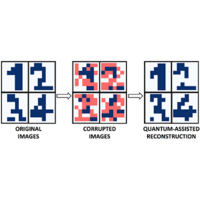Abstract
Mainstream machine-learning techniques such as deep learning and probabilistic programming rely heavily on sampling from generally intractable probability distributions. There is increasing interest in the potential advantages of using quantum computing technologies as sampling engines to speed up these tasks or to make them more effective. However, some pressing challenges in state-of-the-art quantum annealers have to be overcome before we can assess their actual performance. The sparse connectivity, resulting from the local interaction between quantum bits in physical hardware implementations, is considered the most severe limitation to the quality of constructing powerful generative unsupervised machine-learning models. Here, we use embedding techniques to add redundancy to data sets, allowing us to increase the modeling capacity of quantum annealers. We illustrate our findings by training hardware-embedded graphical models on a binarized data set of handwritten digits and two synthetic data sets in experiments with up to 940 quantum bits. Our model can be trained in quantum hardware without full knowledge of the effective parameters specifying the corresponding quantum Gibbs-like distribution; therefore, this approach avoids the need to infer the effective temperature at each iteration, speeding up learning; it also mitigates the effect of noise in the control parameters, making it robust to deviations from the reference Gibbs distribution. Our approach demonstrates the feasibility of using quantum annealers for implementing generative models, and it provides a suitable framework for benchmarking these quantum technologies on machine-learning-related tasks.
1 More- Received 31 October 2016
DOI:https://doi.org/10.1103/PhysRevX.7.041052
Published by the American Physical Society under the terms of the Creative Commons Attribution 4.0 International license. Further distribution of this work must maintain attribution to the author(s) and the published article’s title, journal citation, and DOI.
Published by the American Physical Society
Physics Subject Headings (PhySH)
Popular Summary
Mainstream machine learning, which gives computers the ability to learn tasks that they are not explicitly programmed to do, relies heavily on sampling from complex probability distributions. Quantum computing technologies have the potential to greatly speed up these tasks or make them more effective. However, several limitations have hindered demonstrations of how practical this is. Clearing this hurdle could significantly advance the field of artificial intelligence by improving methods that rely on sampling. We have developed a technique that surpasses current limitations and provides a clear demonstration of feasibility.
Our approach implements a densely connected model in a quantum annealer, a type of quantum computer originally proposed as optimizers but here used as samplers instead. Our algorithm shows how quantum annealers can be trained without full knowledge of the control parameters actually implemented by the device, a more efficient and robust approach to cope with noise in near-term devices. We successfully trained the D-Wave 2X, a quantum annealer hosted at NASA, on image data sets in a generative unsupervised learning setting, one of the most difficult and attractive paradigms in machine learning. Our experiments used up to 940 qubits to generate, reconstruct, and classify small images of handwritten digits. The generated images resemble those produced by humans; we include a visual Turing test to challenge the reader to distinguish them.
Finding quantum speedup in this machine-learning setting would have impacts across science, engineering, and society. Ours is a suitable framework for benchmarking quantum sampling methods against classical ones, a key metric to explore in the near future.



